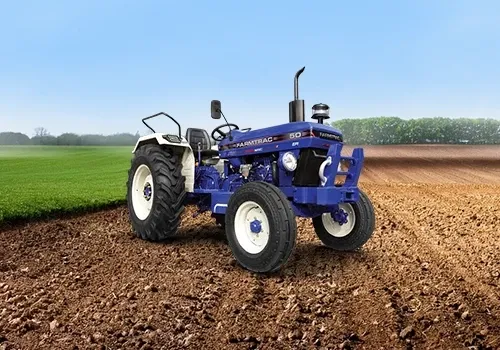Introduction
While feeding the world, agriculture has also been a major contributor to greenhouse gases. One of the major emission sources in agriculture is the use of tractors and other farm implements. Tractors burn fossil fuel, which releases carbon dioxide (CO2) and other pollutants into the atmosphere that contribute to climate change. But tractors are the beating heart of our farming operations, and the carbon footprint is huge , so innovation is helping to bring a greener future into our fields.
Everyone always talks about reducing our carbon footprint.
The carbon footprint of a tractor is the overall GHGs (greenhouse gases) of the tractor in its life cycle. This includes emissions from:
Manufacturing: The manufacture of tractors requires raw materials, energy, and transportation, all of which create CO₂ emissions.
Fuel Consumption: Tractors consume diesel, a leading source of carbon emissions. One tractor can put out multiple tons of CO2 per year.
Maintenance and Repairs: Regular servicing and part replacements also create indirect emissions.
End-of-Life Disposal: Tractors that are scrapped or recycled can impact the environment as well, depending on how the materials are handled.
Strategies for Lowering the Carbon Footprint of Tractors
Farmers, manufacturers, and policymakers can employ a number of strategies to mitigate the environmental impact of tractors:
Switchover to Alternate Fuels
Alternative fuels are one of the best ways to control emissions like
II. Biodiesel: A renewable fuel made from vegetable oils and animal fats that produces fewer emissions than conventional diesel. Exit Full Screen
Electric Tractors—Battery-powered tractors are coming of age and provide a CO2-free direct solution.
Hydrogen fuel cells: Some manufacturers are exploring hydrogen-powered tractors that produce only water vapor as emissions.
Enhancing Fuel Efficiency
Fuel efficiency gains can lead to a radical reduction of tractors’ carbon footprint. Some methods include:
Optimized Engine Design: Recent engines burn less fuel for the same power output.
Public Maintenance: Well-maintained tractors boost efficiency and cut emissions.
Smart Tire Inflation: Properly inflated tires reduce rolling resistance, which lowers fuel consumption.
Embracing Precision Agriculture Methods
There are even new methods of precision farming that use technology to minimize tractor use to a minimum and substantially save unnecessary fuel. Some techniques include:
GPS-Guided Tractors: These systems minimize overlapping passes in the field, which lowers fuel use.
Variable Rate Technology (VRT): By adjusting inputs such as fertilizers based on soil needs, you can avoid running your tractor an excessive number of times.
Automation of Tractors: Self-driving tractors help operate more efficiently, using the least amount of energy and emissions.
To Charge With and to Maintain With Renewable Energy
This would mean that for electric tractors, charging at solar or wind power facilities would zero out emissions even more. Farmers could also bring renewable energy into their operations to limit dependence on fossil fuels.
Policies and Government Incentives
Governments could encourage the shift to greener tractors by:
Electric and Alternative Fuel Tractor Rebate
Tax Incentives for Low-Emission Farming Equipment
To promote cleaner technologies, regulations on diesel emissions.
Farmers and Reducing Carbon Footprints
Yet, which is more important in improving the carbon footprint of tractors: technological improvements or farmers’ habits? Through best practices like:
Crop Rotation and Use of Cover Crops: These methods reduce soil degradation, increasing overall efficiency and reducing the use of tractors.
Reduced Tillage: Reducing soil disturbance lessens the need for fuel and improves soil health.
Community Equipment Sharing: Sharing larger pieces of equipment, such as tractors, within a single farming community can reduce the number of machines needed by farms, reducing emissions in the aggregate.
Investing in Training: Teaching farmers efficient use of machinery, alternative fuel options, and precision farming methodologies would reduce carbon emissions.
Tractors have the potential to become more sustainable in the future.
Innovations in tractor technology herald a future of sustainable farming. Manufacturers are pouring research into developing:
Solar-Powered Tractors: Integrated solar panels are one technology being studied and used by some prototypes of tractors.
Tractor Mimicking Fleets: Multiple electric tractors working together autonomously to optimize field operations.
New technologies for advanced carbon capture: Innovative systems that capture and store carbon emissions from tractors.
Hybrid Tractors: These tractors have electric and fuel-powered engines to keep them efficient and sustainable.
Biofuel Innovations: Next-gen, low-emission bio-fuels are being developed to replace conventional diesel.
While critical to modern agriculture, tractors have a carbon footprint that presents environmental problems. Farmers can substantially lower emissions by switching to alternative fuels, enhancing fuel efficiency, adopting precision farming, and investing in renewable energy. Governments and manufacturers are also key figures in making greener tractors on the market. With the advancement of technology, tractor sustainable solutions will become more effective, paving the way for a farmer-friendly yet environmentally sustainable tomorrow. It is up to policymakers, farmers, and industry leaders to work together to create a sustainable agricultural landscape that balances food production and environmental stewardship.
The agricultural sector, while essential for feeding the world, also accounts for a considerable proportion of greenhouse gas emissions. Tractors and other farm machinery are a major source of emissions in agriculture. If, if you know tractors that run in fossil fuels that release carbon dioxide (co2) and deposit others that contribute to pollution to global warming Nevertheless, due to the development of pioneering machinery and using value-added farming techniques tractors can cut the emissions of a farm allowing for farming to become more sustainable and good for the environment.


